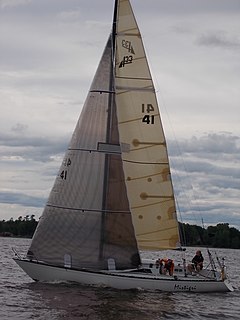Related Research Articles

The Tartan Ten, also called the Tartan 10, is an American sailboat that was designed by Sparkman & Stephens as a one-design racer and first built in 1978.

The Abbott 33 is a Canadian sailboat, that was designed by Jan Torben Larsen and Abbott Boats and first built in 1981.
The C&C 101 is an American sailboat, that was designed by Tim Jackett and first built in 2012.

The Hunter 29.5 is an American sailboat, that was designed by Rob Mazza and the Hunter Design Team and first built in 1994.
The C&C 34/36 is a Canadian sailboat series, designed by Robert W. Ball and first built in 1989. Ball was the chief designer for C&C Yachts between 1969 and 1991.
The Hunter 290 is an American sailboat that was designed by the Hunter Design Team as a cruising boat and first built in 1999.
The Marlow-Hunter 33 is an American sailboat that was designed by Glenn Henderson and the Hunter Design Team and first built in 2012.
The Hunter 33.5 is an American sailboat that was designed for cruising and first built in 1987.
The Hunter 340 is an American sailboat that was designed by the Hunter Design Team as cruising sailboat and first built in 1997.
The Hunter 37.5 Legend is an American sailboat that was designed by the Hunter Design Group and first built in 1990.
The Hunter 41 is an American sailboat that was designed by Glenn Henderson as a cruiser and first built in 2004.
The Hunter 430 is an American sailboat that was designed by the Hunter Design Team as a cruising boat and first built in 1995.
The Marlow-Hunter 50 Center Cockpit, also called the Marlow-Hunter 50CC is an American sailboat that was designed by the Hunter Design Team as a cruiser and first built in 2010.
The Stone Horse is an American trailerable sailboat that was designed by Samuel S. Crocker as a cruiser-racer and first built in 1931.
The Dufour 1800 is a French sailboat that was designed by Laurent Cordelle and Michel Dufour as a trailerable cruiser-racer and first built in 1979.
The Hotfoot 27 is a Canadian sailboat that was designed by Doug Hemphill as racer-cruiser and first built in 1981.
The Bristol 29.9 is an American sailboat that was designed by Halsey Chase Herreshoff as a Midget Offshore Racing Class and International Offshore Rule racer and first built in 1977.
The San Juan 33S is an American sailboat that was designed by David Pedrick as racer and first built in 1981.
The Freedom 35 is an American sailboat that was designed by David Pedrick as a racer/cruiser and first built in 1993.
The Santana 2023 is a family of American trailerable sailboats that was designed by Steve Schock, with models for racing and cruising, first built in 1993.
References
- 1 2 3 4 5 Browning, Randy (2018). "Hunter 336 sailboat specifications and details". sailboatdata.com. Archived from the original on 5 April 2022. Retrieved 29 November 2018.
- 1 2 McArthur, Bruce (2022). "Hunter Marine". sailboatdata.com. Archived from the original on 30 July 2020. Retrieved 5 April 2022.
- ↑ McArthur, Bruce (2022). "Rob Mazza". sailboatdata.com. Archived from the original on 16 March 2022. Retrieved 5 April 2022.
- 1 2 3 4 Staff Report (13 April 2003). "Hunter 336: A Nice Package Sans Backstay". boats.com. Archived from the original on 5 April 2022. Retrieved 29 November 2018.
- ↑ Burns, Thom (1997). "New Boat Review: The Hunter 336". sailingbreezes.com. Archived from the original on 5 April 2022. Retrieved 15 November 2018.